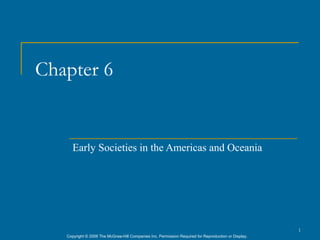
06 bentley3
- 1. Chapter 6 Early Societies in the Americas and Oceania 1 Copyright © 2006 The McGraw-Hill Companies Inc. Permission Required for Reproduction or Display.
- 2. Early Mesoamerican societies, 1200 B.C.E.-1100 C.E. 2 Copyright © 2006 The McGraw-Hill Companies Inc. Permission Required for Reproduction or Display.
- 3. Origins of Mesoamerican Societies Migration across Bering land bridge? Probably 13,000 BCE, perhaps earlier By sea from Asia? By 9500 BCE reached southernmost part of South America Hunter/Gatherer societies evolve into agricultural societies 3 Copyright © 2006 The McGraw-Hill Companies Inc. Permission Required for Reproduction or Display.
- 4. Olmecs 1200-100 BCE The “Rubber People” Ceremonial Centers San Lorenzo, La Venta, Tres Zapotes Olmec Heads Up to 10 ft tall, 20 tons Transported by dragging, rolling on logs 1000/workers per head 4 Copyright © 2006 The McGraw-Hill Companies Inc. Permission Required for Reproduction or Display.
- 5. Agriculture and Herding Staple: maize Herding: turkeys, barkless dogs Both food No draft animals No development of wheeled vehicles 5 Copyright © 2006 The McGraw-Hill Companies Inc. Permission Required for Reproduction or Display.
- 6. Olmec Society Probably authoritarian in nature Large class of conscripted laborers to construct ceremonial sites Also tombs for rulers, temples, pyramids, drainage systems 6 Copyright © 2006 The McGraw-Hill Companies Inc. Permission Required for Reproduction or Display.
- 7. Mysterious Decline of Olmecs Ceremonial centers destroyed No evidence of warfare Revolution? Civil war? 7 Copyright © 2006 The McGraw-Hill Companies Inc. Permission Required for Reproduction or Display.
- 8. Maya huge cities discovered in 19th c. 300 BCE-900 CE Terrace Farming Cacao beans hot chocolate Currency Major ceremonial center at Tikal 8 Copyright © 2006 The McGraw-Hill Companies Inc. Permission Required for Reproduction or Display.
- 9. Maya Warfare Warfare for purposes of capturing enemy soldiers Ritual sacrifice of enemies Enslavement Small kingdoms engage in constant conflict until Chichén Itzá begins to absorb captives Some nevertheless choose death Center of empire develops 9 Copyright © 2006 The McGraw-Hill Companies Inc. Permission Required for Reproduction or Display.
- 10. Mayan Ritual Calendar Complex math Invention of “Zero” Calendar of 365.242 days (17 seconds off) Solar calendar of 365 days Ritual calendar of 260 days Management of calendar lends authority to priesthood Timing of auspicious moments for agriculture 10 Copyright © 2006 The McGraw-Hill Companies Inc. Permission Required for Reproduction or Display.
- 11. Mayan Language and Religion Ideographs and a syllable-alphabet Most writings destroyed by Spanish conquerors Deciphering work begins in 1960s Popol Vuh: Mayan creation myth Importance of bloodletting rituals Human sacrifices follow after removal of fingers, piercing to allow blood flow Self-mutilation of penises, earlobes 11 Copyright © 2006 The McGraw-Hill Companies Inc. Permission Required for Reproduction or Display.
- 12. The Maya Ball Game Ritual form of ball game High-ranking captives, prisoners of war contestants Execution of losers immediately follows the match Bloodletting ritual for the gods 12 Copyright © 2006 The McGraw-Hill Companies Inc. Permission Required for Reproduction or Display.
- 13. City of Teotihuacan Highlands of Mexico Lakes in area of high elevation Village of Teotihuacan, 500 BCE, expands to become massive city Important ceremonial center Extensive trade network, influenced surrounding areas Begins to decline c. 650 CE, sacked in middle of 8th century, massive library destroyed 13 Copyright © 2006 The McGraw-Hill Companies Inc. Permission Required for Reproduction or Display.
- 14. Andean Societies Migration into South America c. 12000 BCE Climate improves c. 8000 BCE Largely independent from Mesoamerica Highly individualized due to geography 14 Copyright © 2006 The McGraw-Hill Companies Inc. Permission Required for Reproduction or Display.
- 15. Chavin Cult New religion in central Andes, 900-300 BCE South America, contemporary Peru Little known about particulars of religion Intricate stone carvings 15 Copyright © 2006 The McGraw-Hill Companies Inc. Permission Required for Reproduction or Display.
- 16. The Mochica State Valley of the Moche River Dominated northern Peru, 300-700 CE Painting survies One of many states in region, none able to consolidate into empire 16 Copyright © 2006 The McGraw-Hill Companies Inc. Permission Required for Reproduction or Display.
- 17. Early societies of Oceania, 1500 B.C.E.-700 C.E. 17 Copyright © 2006 The McGraw-Hill Companies Inc. Permission Required for Reproduction or Display.
- 18. Oceania Prehistoric land bridges, lower seas permit migration Outrigger canoes for open-sea travel Early hunter-gatherer societies in Australia Early agriculture in New Guinea 18 Copyright © 2006 The McGraw-Hill Companies Inc. Permission Required for Reproduction or Display.
- 19. Aborigine of the Naomi Tribe 19 Copyright © 2006 The McGraw-Hill Companies Inc. Permission Required for Reproduction or Display.
- 20. Lapita Peoples Found throughout Pacific Islands Agriculture, animal herding Political organization based on chiefdoms Trade over open ocean declines 500 BCE Greater independence of settlements 20 Copyright © 2006 The McGraw-Hill Companies Inc. Permission Required for Reproduction or Display.